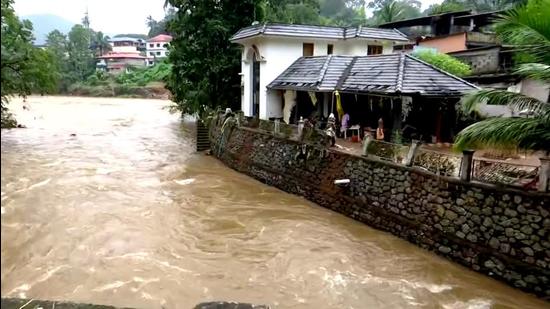At COP 26, India’s balancing act and dialogue on material support
It will enable India to identify a pathway that balances national developmental needs with global climate priorities
The multilateral dialogue at the 26th session of the Conference of the Parties (COP 26), aimed at limiting average global warming to 1.5 degrees Celsius above pre-industrial levels, will be rooted in a heightened urgency for climate action. This urgency has been accelerated by the latest Intergovernmental Panel on Climate Change (IPCC) report, which identifies the need for climate action that requires a highly ambitious and unprecedented transformation of systems.

In no uncertain terms, IPCC has stated that extreme weather, climate action failure and human-led environmental damage are going to be risks with the highest likelihood (of occurrence) and impact in the coming decade. There is a pre-COP26 consensus for a more aggressive era of climate action, which is the need of the hour.
India has its heart in the right place when it comes to adapting to and mitigating the climate crisis. But it faces the challenge of achieving in parallel, its over-riding development priorities of eradicating hunger and poverty, and creating jobs; a vision of sustainable and inclusive development; and its climate action goals.
In spite of India’s critical development concerns, its Paris commitments have translated into substantial climate action.
India today ranks among the few countries on track to meet most of the climate commitments it made under the Paris Agreement. The country’s renewable expansion rate, among the world’s fastest, has translated into 100 GW of installed renewable capacity and is on track to a stated goal of 175 GW. There is an even more ambitious target — installed renewable capacity of 450 GW by 2030. The 450 GW target would mean that India would generate 60% of its electricity from non-fossil fuel sources by 2030, well beyond the 40% target in its Paris pledge. Apart from renewable energy, the National Hydrogen Mission has placed green hydrogen at the core of India’s energy security, and could emerge as a strong alternative to address India’s energy needs.
Other goals include land degradation neutrality and making Indian Railways a net-zero carbon emitter by 2030. In parallel, India has activated a far-reaching policy framework to support electric vehicles (EVs), indicating the government’s thrust in moving towards a low carbon transport system. With the Faster Adoption and Manufacturing of Hybrid and EV (FAME I & FAME-II); Production Linked Incentive (PLI) schemes; enhancement of e-charging infrastructure; and reduction of Goods & Services Tax (GST) on EV purchases, this sector can play a significant role in India’s green narrative. India’s climate actions reflect that it is willing to go above and beyond its nationally determined contribution (NDC); in parallel, India has achieved significant milestones in poverty reduction, infrastructure development and health care access.
In this context, India’s COP26 outlook can be seen as a balancing act between environmental sustainability and overall development. More importantly, there is strong merit in considering how dialogue at COP26 translates into material support for more sustainability efforts, at the Indian and the global level. This material support has four aspects.
First, financial support for the scale of the transformation envisioned. Sufficient financial support can stimulate new clean energy initiatives, strengthen ongoing initiatives, and finance research and development and infrastructure that India needs to leapfrog to a cleaner energy pathway.
Second, commitments from developed countries to increase technical and capacity-building support and cooperation.
Investment in low-carbon technologies and innovation can help India accelerate its own actions and enhance its ambitions, including accelerating its EV transition journey, ramping up the net impact of India’s current and upcoming renewable assets, and creating feasible options for low/zero-carbon energy pathways.
Third, commitments from all governments to scale up their ambition and put in place climate plans that keep 1.5 degrees Celsius within reach, thereby avoiding the worst impacts of the climate crisis and minimising the future cost of adapting to the crisis. Both issues directly impact India’s growth and development potential. And like every other nation, the challenge for India is about increasing its ambition.
Finally, to build on India’s adaptation and resilience efforts by enhancing institutional, technological, and financial support and collaboration to leverage the power of nature-based solutions in addressing both climate and nature challenges. And, simultaneously, preserve, protect, and harness our natural assets, including our forests, water bodies and air, thereby leading India towards a low-carbon, climate-resilient future.
This latter aspect is founded in an appreciation of India’s sizeable natural assets. For example, our 7,500-km coastline — comprising rich ecosystems with extensive mangroves, seaweed beds, salt marshes and coral reefs that provide essential ecosystem services — can be effectively leveraged for a sustainable ocean economy.
About 250 million people reside within 50 km of India’s coast, many of whom depend on the sea for their livelihood. By absorbing heat and CO2, the oceans have so far lessened the effects of the climate crisis. But oceanic CO2 saturation will result in larger volumes of atmospheric emissions, while simultaneously threatening the marine ecosystem.
For developing countries such as India, such material and institutional support will greatly enhance the pace of climate action. It will enable India to identify a pathway that balances national developmental needs with global climate priorities. It will also enable participating countries to identify how they can best help each other — and India — to accelerate the shift to a cleaner and greener world.
Sanjiv Mehta is chairman and managing director, Hindustan Unilever Limited and president, Unilever South Asia
The views expressed are personal



